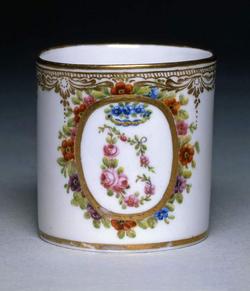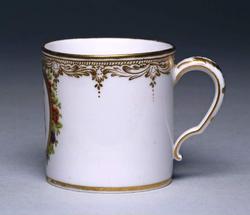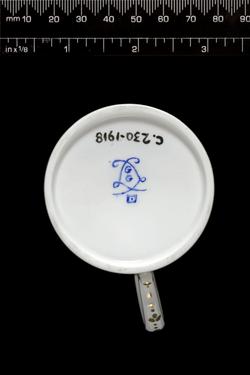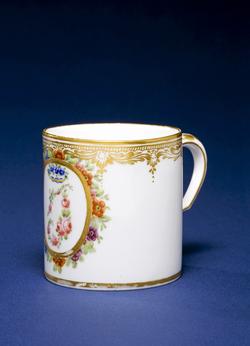Current Location: Gallery 26 (Lower Marlay)
Titles
Gobelet litron
Maker(s)
Factory:
Sèvres Porcelain Manufactory
Painter:
Tardy, Claude-Antoine
Entities
Categories
Description
Soft-paste porcelain cup painted in enamels with a crown over a T made up of flowers and foliage, and gilded borders
Soft-paste porcelain, lead-glazed and painted in blue, green, and pink, enamels, and gilded. Cylindrical cup with a double-curved handle. The front is painted with a crown of blue flowers and green leaves above a script T made up of pink roses and green leaves, surrounded by an oval frame of chased gilding bordered by polychrome flowers. A border of stylized gilt leaves runs round the upper edge, and bands of gilding encircle the foot and lip. The handle has gold lines on the sides, and stylized leaves and flowerlets down its back.
Notes
History note: Unknown before donor, Ralph Griffin, MA, St John's College, Cambridge
Legal notes
Given by Ralph Griffin, MA, FSA
Measurements and weight
Height: 6.8 cm
Acquisition and important dates
Method of acquisition: Given
(1918)
by
Griffin, Ralph
Dating
18th Century, Late
Louis XVI
Production date:
circa
AD 1784
: The cup bears the date letter for 1784
Note
Cups decorated with initials were a new venture initiated by the comte d’Angiviller in the summer of 1784, after he had seen Clignancourt cups decorated in this way. Between then and 1789 over 1000 were produced. Sir Geoffrey de Bellaigure (see Documentation) cited over 80 in 1784, over 400 in 1785,nearly 500 in 1786, about 160 in 1787 and fewer than 20 in 1788. He identified this as possibly as one of three gobelet litron decorated by Tardy for which he received payment shortly after
19 August in 1784 (MNS Vj’3, fo. 257). Floral initials were also painted by C.-N. Buteux.
The gobelet litron was named after a cubic measure, the litron, which was normally made of wood, and was used for dry stuffs, such as corn and peas. Its size in Paris had been defined in 1670 as the equivalent of 9.45 cm high and 10.15 cm in diameter in pouces and lignes, which was larger than the largest of the porcelain cups. The first size of gobelet litron had been introduced at Vincennes before October 1752 when it was mentioned in an inventory of stock, but was probably being made a few years.The second and third sizes followed in 1753, and the fourth and fifth in 1757. They could be fitted with one of seven different handle forms . A drawing in the archives at Sèvres is dated 19 February 1753 (MNS, R1, liasse 2, dossier 2, No. 6bis) They were supplied singly, singly with a plateau carré, in ’harlequin’ sets, or as part of matching dejeuner. (See Documentation, Préaux 1991, Bellaigue 2009, Savill, 1988)
This is a gobelet litron of the second size with Savill's handle B. This size was usually supplied separately rather than in a tea set. Its decoration suggests that it was bought as a gift for someone with the initial T.
School or Style
Louis XVI
Components of the work
Decoration
composed of
enamels
( blue, green, pink)
gold
Handle
Materials used in production
presumed lead-glaze
Lead-glaze
Soft-paste porcelain
Techniques used in production
Moulding
: Soft-paste porcelain lead-glazed and painted in blue, green, and pink, enamels, and gilded.
Lead-glazing
Inscription or legends present
Inscription present: 48 with a semi-circular curved strok beside it
- Text: 48
- Location: On base of cup
- Method of creation: Incised
- Type: Mark
- Text: 9 or 6
- Location: On base of cup
- Method of creation: Incised
- Type: Mark
- Text: interlaced Ls enclosing G over G
- Location: On base of cup
- Method of creation: Painted in blue enamel
- Type: Factory mark
Inscription present: square with dot in the middle
- Text: square with dot in the middle
- Location: On base of cup
- Method of creation: Painted in blue enamel
- Type: Painter's mark
References and bibliographic entries
Identification numbers
Accession number: C.230-1918
Primary reference Number: 86618
Stable URI
Audit data
Created: Saturday 6 August 2011
Updated: Wednesday 13 January 2021
Last processed: Thursday 14 August 2025
Associated departments & institutions
Owner or interested party:
The Fitzwilliam Museum
Associated department:
Applied Arts
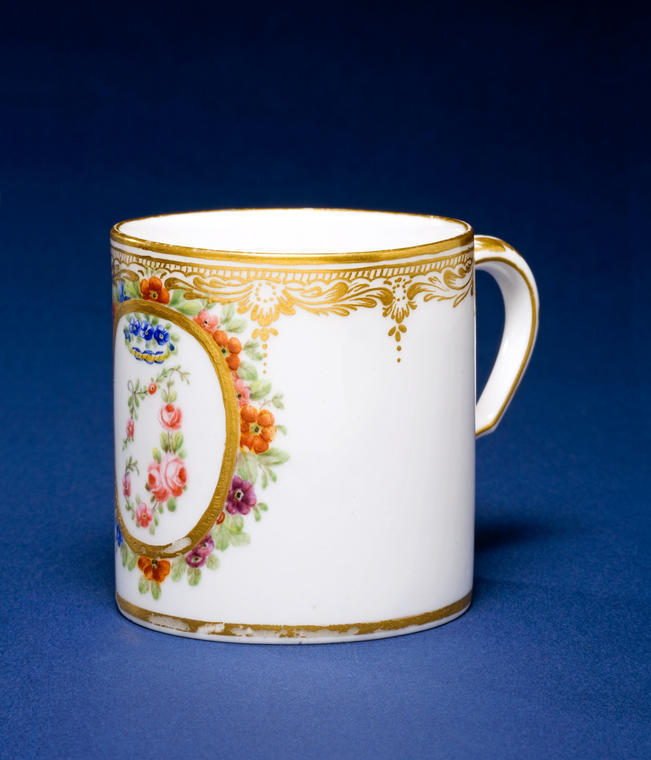
 IIIF Manifest
IIIF Manifest
